One very useful framework for studying society is in terms of grid and group, an approach created by anthropologist Mary Douglas more than fifty years ago in her book Natural Symbols, and then elaborated upon by her and others in the years since. Without bogging ourselves down in the minutiae of the theory, Douglas contends that a parsimonious description of society can be achieved in terms of two dimensions, which she called grid and group. These correspond respectively, in a very loose way, to social control and hierarchy on the one hand (grid), and strength of social-identity and boundedness on the other (group). The exact descriptions vary, as do the diagrams used to describe it.

Anthropologist John McCreery explained it to me this way:
Mary Douglas … proposal of “grid and group” … represented an important departure from 1-dimensional analyses of ritual in which ritual was assumed to be “primitive” and rationality “advanced.” To Douglas a self-described “Bog-Irish Catholic,” the equation of ritual with backward superstition was personally repugnant, but as an anthropologist she felt compelled to look for an alternative. Her focus was the use of the human body as a natural symbol of society. Her approach was fundamentally Durkheimian, assuming that attitudes toward different types of ritual index different types of societies.
Group=concern with social boundaries, embodied in taboos surrounding food, sex, blood and excrement.
Grid=concern with hierarchy, embodied in rituals asserting power and prestige.
In the group-and-grid diagram, there are two orthogonal dimensions: Group and Grid. Both vary from High to Low in intensity. Douglas’s ethnographic prototypes are
(1) for Low Group, Low Grid, Colin Turnbull’s Ituri Pygmies and Frederick Barth’s Basseri nomads. In both individuals move freely from one egalitarian group to another. Ritual is unimportant.
(2) for Low Group, High Grid, Melanesian “Big-man” societies like Malinowski’s Trobriand Argonauts of the Western Pacific. Taboos related to food, sex, etc., are weak but huge effort is devoted to competitive display.
(3) for High Group, Low Grid, Douglas chooses the Israeli kibbutz, ostensibly egalitarian but keeping kosher and maintaining strong group boundaries.
(4) in the High Group, High Grid quadrant, we find the baroque elaboration of ritual associated with traditional civilizations in the Middle East, China, India, where both strong boundaries and competitive displays are prominent features of society.
Are these ideas still relevant in today’s world? Douglas herself noted the similarity between hippies and Turnbull’s Forest People. Her analysis of Melanesian Big Men stands up pretty well with analysis of transnational corporations and Silicon Valley billionaires.
John McCreery (personal communication)
In general, a society of any sufficient complexity, might be composed of combinations of these four types, in some rank order of general prevalence or preference. So, for example, there might be a strong hierarchy present, with widespread support, but factions within that society might prefer a more egalitarian re-ordering of society. It is notable, for example, that while Scandinavia itself was undergoing a process of increased centralization at the time, the settlement of Iceland by the Vikings led to the establishment of the Icelandic Commonwealth, a king-less society. Many of those that settled the northern Atlantic were disaffected with the increasing power of the monarchs at the expense of local chieftains. Similarly, you might have groups with a strong sense of identity, holding themselves apart from the wider, deeply hierarchical, society they live in, but remain committed egalitarians within their group.

The interesting thing to us, in terms of world building in a fantasy setting, is the potential for the grid-and-group approach to help clarify to us not only the organic structure of the cultures in our fantasy world, but its potential stresses and conflicts, and the motivations of its existing institutions and, ultimately, it’s NPCs. Also, it encourages us to consider possibilities we might not otherwise have done. For example, in our setting, originally conceived as occurring in the context of an uncertain struggle for the throne, it occurred to us that not everyone would be committed to the institution of the kingship itself, particularly in a new and wide-open land, in which the threat of foreign conquest is remote. So we’ve added NPCs advocating for a third way, willing to let the current hero king sit on his throne, out of respect for his accomplishments for his people, but less willing to allow anyone to succeed him, or at the very least, especially in the case of the magnates, weakening the institution to reclaim their own independence.

And what of the vikings themselves, historically, but also in our fantasy setting? Where in the grid-and-group diagram did they fall? To which groups did they feel they belonged, and how committed were they really to maintaining a distinct Norse identity, much less the hierarchical one? What was the organizing principle of Viking society. Was it kinship? Friendship? Patronage? First, we might ought to resist insisting that there was one answer to that question, as the Viking age was an era of substantial change, and there were important regional differences as well. Inland populations tended to rely on a mix of horticulture and hunter-gathering, and were more loosely integrated into the political entities of the more populous coast-lands; there was also significant and systematic interaction between Nordic Scandinavians and Sámi and Finnish peoples of Scandinavia. However, it is clear that both ritual and competitive display of wealth or power were important in less marginal Nordic populations (see, for example Ibn Fadlan’s famous account of the burial of a Swedish chieftain). But it is also clear that the Norse who settled the North Atlantic were quick to seize upon the chance to live free of such excess, nor, we think could it have been sustained there.


